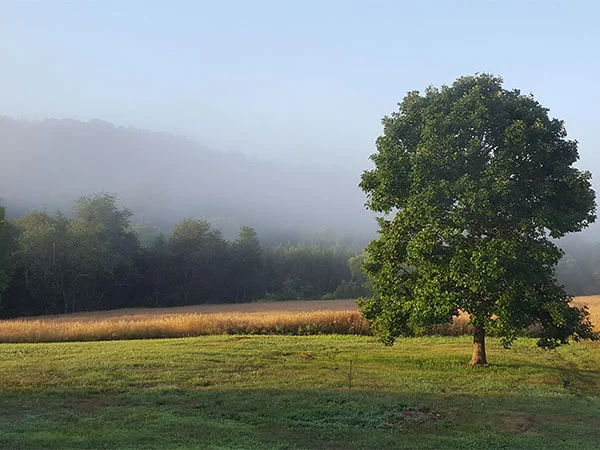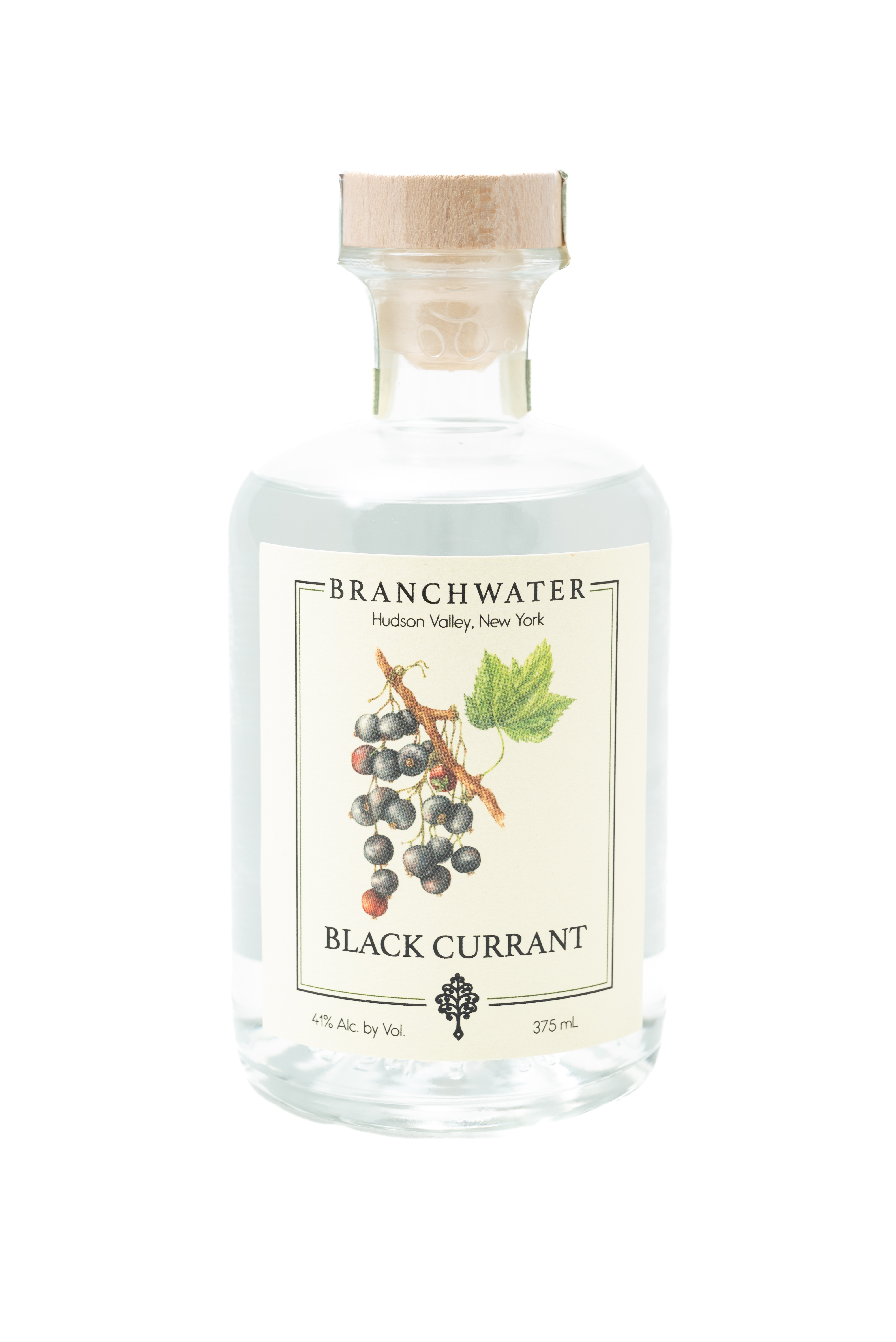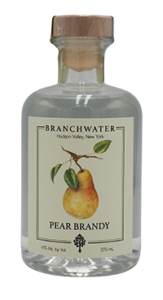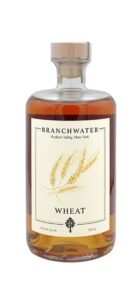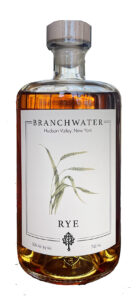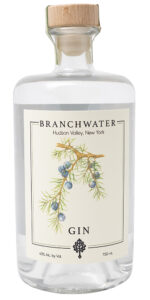“We sought to transform this abandoned mixed farm through integrated, organic, and regenerative practices. Our aim is to make spirits that are the purest, most complex liquid expressions of place.” — Robin Touchet and Kevin Pike
Look down at the Hudson Valley as a bird would. Orient yourself along the broad, north-south river line. Emerald forests and flaxen fields spread outward in succession. Drift lower. A gentle hollow, banked by soft hills, draws the eye. The fine vein of a creek, the glint of a barn roof come into view. Glide over at just the right late-summer moment and you’ll catch a glimpse of a rumpled white quilt — a field of buckwheat in full flower, growing waist-high and humming with life from root to bloom.
Welcome to Branchwater Farms.
Why “Farms,” plural? The answer is revealing. Ever since Robin Touchet and Kevin Pike found and purchased Branchwater, their vision was of an integrated ecosystem of micro-farms, a polyculture of grains, woods, and animals cultivated in accordance with organic and regenerative farming principles. In the process, they’re building bonds they hope will become exponential as more people learn about this work and the promise it offers for our planet’s future.
Past
It is difficult to know how this parcel of land was lived on and managed before European colonists arrived. It was most likely populated by native Mohican (or Mahikan) people. Their lives were rooted in the woodlands and the surrounding water systems. Some geographical landmarks, like the Little Wappinger Creek that runs through the farm today, carry the names of native forebearers.
Historical records indicate the farm was established in the late 1700s. Much of the land was deforested in the 1800s. But, as photographs show, a century later, small stands of fruit trees had taken hold. One image, from the 1940s, shows a form of polyculture in vibrant practice: an integrated, diverse system of small, dedicated parcels, separated by tree lines, waterways, and stone walls, supporting a mix of crops and animals. Robin and Kevin consider that period to be a golden era for this land, one they aim to recreate in accord with its natural inclinations. At Branchwater’s heart is a post-and-beam cow barn, built in the mid-1800s. With loving care and expert craftsmanship, they’ve brought it back to life as Branchwater’s distillery and tasting room.
The Growers
Nature determines most of the parameters of a farm. But its organizing principle comes from people: traditions and intentions, gifts and constraints. Robin Touchet and Kevin Pike purchased Branchwater Farms in 2014 and have made their home and life there since.
Robin grew up in northern Virginia, but her fondest memories are of exploring her father’s family farm in Louisiana. She always loved the wild (and was a little wild herself!). After graduating from the University of Virginia with a major in art history, her restless soul led her to Oregon and Italy, before settling in New York City. There she began a career in wine sales — and met her future husband.
Kevin grew up in Columbus, Ohio, but as a kid was happiest exploring his mother’s family farm in Iowa. After graduating from Swarthmore College with a degree in English literature and dreams of writing the great American novel, Kevin returned to Ohio and worked part time in wine retail to support his ambitions. Eventually Kevin moved to New York to oversee national sales and marketing for a large importer. After 13 years, he set out on his own, establishing Schatzi Wines. But he also had a long-held urge to grow and make something himself. When he and Robin found Branchwater Farms, that vision came more clearly into focus.
While they humbly acknowledge their role as the animating force that brought Branchwater Farms to new life, they also readily acknowledge how much of their dream has been made possible by their cherished extended family of friends, neighbors, colleagues, and mentors. Robin and Kevin like to think those spirits are distilled into theirs.
Fields and farming
While still very busy with their wine work lives, Robin and Kevin suddenly found themselves farmers. They planted red clover, started a compost program, cut hay. They ran soil tests and learned they needed to condition the earth with tons of lime from a nearby quarry. They planted winter wheat and rye. And they soaked up all the information they could find about things like open-pollinated heirloom corn varieties and beekeeping.
Inevitably, their inexperience led to some failures. Wild turkeys ate the corn, a crop was lost to drought. They read more, asked harder questions, and looked to the land itself for answers.
Three years in, they initiated a more comprehensive program of crop rotation, cover crops, and no till. Their goals shifted from high crop yields to retaining water, opening the soils, and building their health. With this approach, something completely different began to emerge: the fields developed robust biomass through which came clover, radish, and rye.
Soil tests at the end of 2018 further confirmed their new ideas were working. That summer, a carpet of white buckwheat flowers, a good source of pollen and nectar for their bees, gave visual assurance as well.
But they still felt they needed guidance from someone who knew how rocky the road to regenerative farming can feel. Enter Mimi Casteel. Mimi has an extraordinary ability to explain the most complex concepts in regenerative agriculture with clarity and compassion. In spring 2019, Mimi came to Branchwater to walk the land and help Robin and Kevin understand what the land was asking them to do. Since that visit, there have been days when they look out at the fields and think, Oh dear God, what a mess! But Mimi says that’s as it should be. They find genuine excitement in letting go and waiting to see what happens next.
Now, Branchwater pulls from a broad palette of holistic farming ideas: The biodynamic practice of brewing and applying compost teas. No-till, which comes from ancient customs. Masanobu Fukuoka’s “do-nothing” technique. Taken together, these form a philosophy of farming that prioritizes repairing nature’s processes instead of interrupting them.
Why does all this matter for Branchwater’s spirits? Robin and Kevin believe regenerative farming will have a tangible impact on the vitality of their grains. By laying the groundwork for the symbiotic network between plant root and soil fungi called mycorrhizae, their plants will be able to take up nutrients they need and put back into the soil those they do not (other plants will happily use them!). This should mean more carbohydrates stored in the grains themselves, which should provide more sugar to unlock in fermentation.
Might their choice to work with heritage grains also produce more complex flavors once fermented? They think the answer is yes. Kevin’s research into heritage wheat shows a definite correlation between heritage varieties and bread flavor and complexity. Why wouldn’t the same be true of spirits?
They wanted to work with heirloom grain varieties — wheat, rye, and corn for gin, bourbon, and rye — because of how they farm. For instance, they selected an old variety of wheat called warthog because it produces a very long straw that puts the grain head almost two-and-a-half feet above the ground. They need that because there’s no way they could get modern varieties (which are shorter) ripe enough before competing plants take over.
Their current focus is on Danko Rye, a high-growing hybrid known for its spicy qualities, for whiskey; Bloody Butcher, used by distillers in the 19th century, for bourbon; and experiments with Red Fife, Warthog, and Rouge de Bordeaux wheat, for gin.
But a central tenet of regenerative farming is always have something growing in the fields. Robin and Kevin have co-planted oats, winter peas, clover, buckwheat, and daikon radish to increase biodiversity, add nitrogen, biomass, and water-retentive capabilities, and to prevent erosion and water run-off.
Beyond their own grains, Robin and Kevin look to the abundance of the Hudson Valley for responsibly farmed produce they cannot yet grow themselves.
Finally, one ingredient that is too often overlooked: Water. Water makes up as much as 50 percent of spirits. But most producers just turn on the tap and hope for the best. Robin and Kevin draw on their own, carefully analyzed well water for their spirits because they see it as another important expression of place.
Distilling
With everything they’re doing to grow the highest quality grains, Robin and Kevin can’t imagine taking the risk of degrading those ingredients with imperfect processing. Quality starts in the fields with farming, but it’s preserved in fermentation and refined by distillation.
The system at Branchwater is the culmination of a life’s work of trial-and-error design experience and peerless expertise in distillery systems designed by the legendary Austrian master distiller, Hans Reisetbauer.
Hans is obsessed with rendering the fruits of the landscape as the highest quality spirits. He started designing stills in 1994 and is entirely self taught. His uncompromising standards and willingness to try everything in pursuit of perfection have earned him respect around the world. Hans has invested decades in refining the calculations of time and temperature for each ingredient and vintage condition, every stage of fermentation and distillation. When Kevin told Hans he wanted to try the same thing here, Hans not only gave his full support but also had the extraordinary patience to wait for seven years to get it all going. Branchwater Farms is the only spirits producer in the U.S. he has chosen to work with.
Here’s how it works: After harvest, Kevin and Robin store the grain they grow as whole grains in bins behind the barn. Underneath each grain bin is a flex auger system that connects the bins to the grist house and the mill. Another flex auger connects the mill to the grist case inside the barn. The point of this system is to have a seamless transport of the whole grain from storage to the mill and into the mash tun for processing.
Timing is critical to the quality of Branchwater Farms’ spirits. Fermentation and distillation are performed in tandem because once the fermentation is complete, it must be distilled immediately. The cooling water from the distillery can be collected while it is running in the hot water tank. This tank can then be heated with steam to the temperatures needed to convert starch into fermentable sugars.
Robin and Kevin’s experience with wine informs the way they handle the grain. They mill it just before fermentation to prevent oxidation of the grist and to preserve fruitiness in the resulting fermentation. When the ferment is distilled, the result is a sense of sweetness on the palate.
Distilling is concentrating the essence of what was fermented by separating ethanol from water, solids, and other chemical compounds in the fermented mixture. It is about time and temperature. It is also about the tools and the process. Most importantly, it is about aroma and taste.
